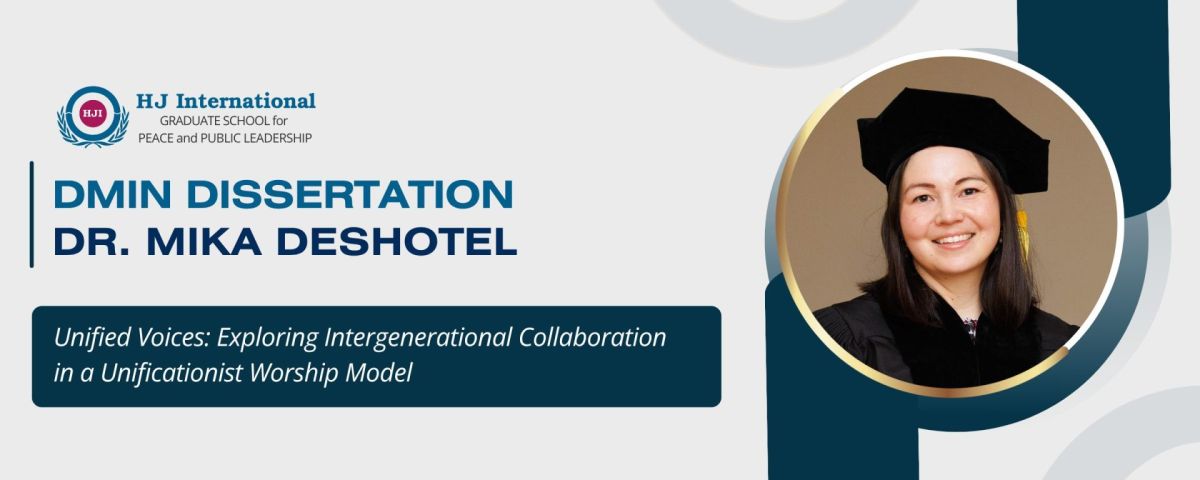Unified Voices: Exploring Intergenerational Collaboration in a Unificationist Worship Model

Doctoral Dissertation Project Summary by Mika Deshotel | M.Deshotel@hji.edu
Abstract
This study looked at the effects of monthly intergenerational worship services within a medium-sized Northeast Unificationist community in Bridgeport, Connecticut. The services sought to empower intergenerational collaboration and leadership within the community, while exploring congregants’ sense of belonging, appreciation of one another, and an overall sense of shared commitment to the community’s future. Surveys were conducted at various times over a 5-month period, uncovering the importance and challenge of relational ties within the community, which can be strengthened through intergenerational faith practices.
Statement of the Problem
The purpose of this project was to facilitate intergenerational collaboration and leadership through the creation of an intergenerational worship model. As a young Movement founded in the early 1950s in Korea, like early religious movements of the past, the Unification Church is at a critical juncture in its history, and a large determinant of success lies in how well the tradition and values of the faith are transmitted to succeeding generations. Like many Christian churches in America, Unificationist churches tend to be led by older members, with lower attendance and interest shown by young families. As an “events-driven” Movement, focusing on large rallies and working with key political and civic leaders towards peace, this has also created a challenge for many young families to find their place. At the same time, while elders are hoping desperately to imbue their skills and faith experiences onto the next generation, they are also feeling challenged to relinquish long held positions in top leadership. Thus, a mechanism needs to be put in place to support stronger relationships and natural collaboration between the generations. Reflecting on this writer’s experience as a Unificationist pastor, it became clear that intergenerational worship would be a key practice in opening the doors for such possibilities.
Research Questions
The main research question addressed through the study was about how an intergenerational worship model could help sustain the development of the community. With subsequent questions as follows:
- What was/were the greatest barrier(s) to working together intergenerationally?
- What efforts were needed to engender feelings of community responsibility and consciousness?
- What were the key factors of success in an intergenerational worship model that could be universal enough for application in diverse Unificationist communities?
- What aspects of our tradition and values were most celebrated between generations and resulted in greater feelings of unity and trust between generations?
Key Findings
A total of 118 respondents participated in the surveys, conducted both before and after intergenerational services. Overall, family closeness and strong community made up the majority of what participants described as the “best part” about their faith community. In a similar way, communication breakdown and generational divisions were most noted as the most “challenging aspect” of the community, with overwhelming value given to intergenerational practices in having the potential to create opportunities for improved communication and strengthening community.
Rating statements revealed that close to 90% of participants agreed or strongly agreed to appreciating intergenerational services. Over 80% of positive responses also revealed that participants felt a greater sense of belonging as a result of such services, as well as being able to “see God in others” through such services. The highest negative responses came from a handful of older First Generation members, and had to do with statements that reflected reciprocity, or the idea of relating well and learning from others, and mutuality, or feeling a shared sense of purpose towards a successful future.
Looking more closely at differences between age and faith generations and their respective preferences within an intergenerational service, results revealed that music was an overall unifier, appreciated by every generation. Music is also an easy to practice and share tradition, as the Movement has its own genre of Holy Songs. The youngest and oldest members appreciated hands-on activities, skits and games. The older GenZ/ Millennials, representing mainly Second Generation, highlighted the value of making services fun, with a short universal message. This group, along with their parents’ generation, the Boomers, appreciated conversations at the table also. The GenXers, who are currently in their mid-40s and late 50’s, were the most traditional, appreciating ritual aspects of our services like reciting the pledge, listening to a meaningful message, and singing Holy Songs.
Recommendations
- Communities seeking to implement intergenerational faith practices should first seek to create an intergenerational team to lead such an effort. This is what was done in CT. Intergenerational teams should be representative of the community and should strive to showcase diverse members of the congregation within their services/ activities
- Communities should seek to create goals that ensure that typically underserved and underrepresented groups are being considered in regular planning, like young families, women, and children
- Communities should seek to implement religious educators, or those who are most concerned about the success and well-being of Blessed Families, like BFM reps or even ‘wise women’ of the community, and allot resources for the support of the diverse and growing needs of our communities, paying special attention to our elderly
- Intergenerational practices are both intentional and innovative. Such practices are meant to be done in a methodical way over many years, which can help build trust and buy-in from congregants, along with providing a greater sense of stability for posterity





